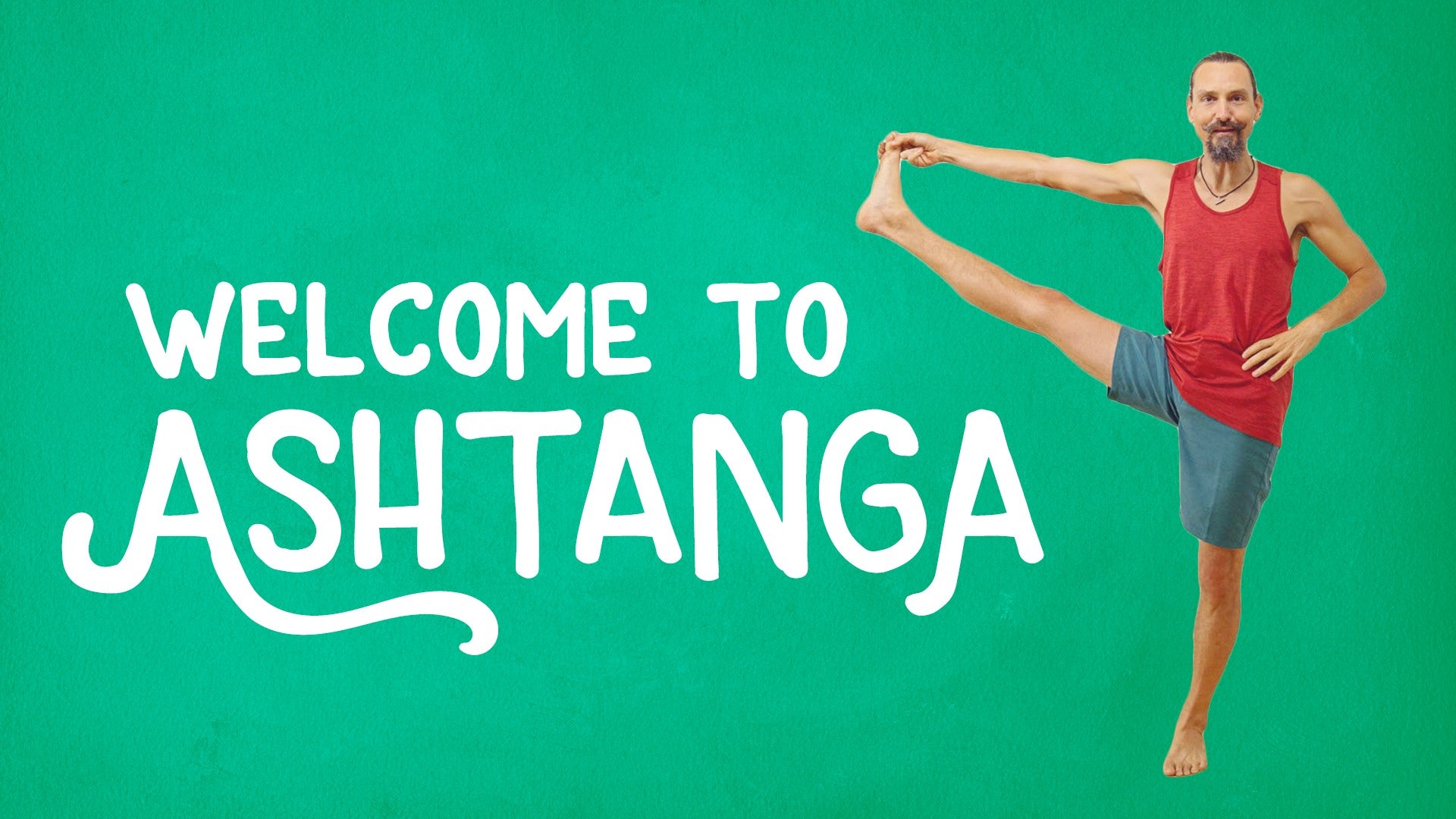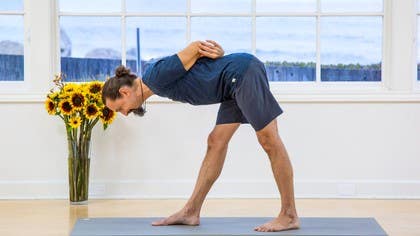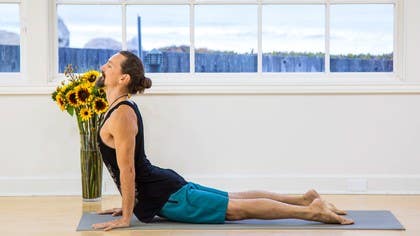Description
Transcript
Read Full Transcript
Welcome. Perhaps the most important thing you could do in this practice is be aware of your breath. There's a very specific style of breathing linked and guiding the Ashtanga practice, which you're free to explore right now in standing or seated as you like. Challenge yourself with long, full deep breaths and see if you can find the vibration rolling at the back of the throat. Also honoring the inhale, the exhale and the spaces between the breaths.
So as you inhale, feel the chest filling with breath, hear the vibration and then notice as there's a slight pause, the lungs are full of breath, the back of the throat stays open and then slowly begin the exhale measuring the breath and at the end of the exhalation again allowing for a pause before the inhale begins. So take a few breaths here, not hurrying, not worrying, just allowing yourself long full deep breaths and honoring the pauses that occur in between the breaths. And then come to standing at the top of your mat and we'll see how the breath actually creates and guides the movements that lead us through the Ashtanga practice. Standing completely, allowing for the slight pause and then Ekam inhale, allowing the chest to open, the arms to float upwards, inside the breath moving, allowing the hands to meet one another as the inhale finishes and then exhaling and during the middle of the exhalation allowing the hands to move down to Samastitihi, finish the movement, finish the breath. Then Ekam inhale, the arms float in response to the breath, the hands meet.
And then not moving, begin the exhale and in the middle of the exhalation the hands go down to Samastitihi so it might look and sound like this. In this manner we honor the pauses that occur in between the breaths as well as the natural pause of the physical movement, gaining more control and more subtlety into a refined practice. As the breath moves the body and the body makes the shape of posture, then the third stabilizing element, the eyes gaze upon a single point. In Sanskrit we refer to this as Drishti. So again exhale completely and then Ekam inhale, allow the arms to float up during the middle of the breath, finish the movement, finish the breath and allow the eyes to stabilize the posture by gazing on the thumbs, begin the exhale and then break the Drishti, allow the hands to move down, gazing forward, finish the movement, finish the breath, Ekam inhale, the arms come up, the eyes settle onto the thumbs and then exhale to Samastitihi eyes just gazing straight forward.
Now we'll add in a few more Drishtis and a few more postures. Importantly here in the second breath as you take a forward fold, we'll ask the eyes to look down the tip of the nose. In Sanskrit we call this Nazagrai Drishti, the point of the nose. And so your eyes will be focusing in down the tip of the nose and this will create a real centering experience as the awareness is guided inwards. You may find that this links your awareness to Mulubanda, the root of the pelvic floor, the lock that happens at the very base of the pelvis and this will be explored in further tutorials and lessons.
For now come back to standing, top of the mat, exhaling completely, Ekam inhale, the arms float up, see your thumbs meet, Dway begin the exhale, break the Drishti and now go into a forward fold, bending the knees as needed, dropping the head down, finish the breath and look down the tip of the nose and then Trini inhaling, during the middle of the inhale the head lifts, the eyes journey forward, Ashtau exhale, during the exhalation drop the head down and find the eyes gazing down the tip of the nose, Nava inhale, during the inhalation rising up the hands lift, see your thumbs, exhale, back to Samastitihi. Now we'll explore Sun Salutation A, this will encourage a lot more gazing down the tip of the nose as best you can trying to keep Nazagarai Drishti during Chaturanga, upward dog and downward dog, those fundamental postures so that as we move forward through the sequence we keep stabilizing and drawing awareness more deeply internal. Exhale completely, Ekam inhale, arms up, see your thumbs, finish the inhalation, pausing, begin the exhale, moving forward during the exhalation, see the tip of the nose and finish the breath, not moving, Trini begin the inhale, then the head lifts in response to the breath look forward and Chaturari exhaling, stepping or jumping back to Chaturanga, the chin is forward but the Drishti down the tip of the nose, Pancha inhale to upward facing dog still looking down the tip of the nose, Shat exhaling to downward facing dog, we'll take five breaths together here, one, you may be able to keep the eyes centering on the tip of the nose, two or that may become difficult for you to maintain in which case three, you pick a still spot on the knee, you could look on the navel, a more traditional Drishti there, four, as long as your eyes are centred on one still point, five, Sapta inhale, breaking the Drishti, moving inside the breath, feet together, head lifts, look forward and Ashta exhaling, folding forward again the eyes look down the cheeks or towards the nose, nava inhale rising up, seeing the hands meet, exhale to Samastitihi. The practice of moving inside the breath tied with keeping a stable and steady Drishti will teach you a lot of patience and restraint and this will become a practice of patience for you. Let's see how that plays out in one of the standing postures.
Let's explore the posture, Parsvottanasana, inhaling, step your left foot back, so we'll go over the right side first, keeping the legs straight and strong, the heels in a line and the hips square to the front of the room, breathing naturally here in the ideal Vinyasa account, the same inhalation would take their hands together behind the spine and bring the pinkies up the back, if that's too much to ask right now on the wrists or shoulders you might just simply modify by grabbing the elbows back behind you as best you can, if that's too much of a reach in you might simply be taking forearms. But regardless of the hand position take an inhalation that finds the chest really lifting the shoulders rolled back and down and then begin your exhalation letting the chest lead the way forward, let the shoulders lag behind and look onto your right big toe, keep the upper back lengthening and long, avoid the hunching or the crunching even if it means you don't come down so deeply and breathe, simply looking on the right big toe. Notice if your eyes have a tendency to want to journey away and just let them settle softly onto the right big toe, nothing to learn about the big toe there, we're just letting the eyes rest as we stabilize our awareness on our breath, exhaling completely, trini begin to inhale and then break the drishti allowing the body to rise in response to the breath, pivot on the heels and change the side, your hips are square to the back, exhale folding over the left leg looking towards the left big toe, the chest leads the way and the shoulders lag behind keeping the broad collarbone experience with you, if you're able to keep the upper back very long you could lean forward more deeply into the posture as long as the eyes are stabilized on the left big toe, exhale completely there then punch and begin to inhale, let the body come up in response, release the arms outwards and exhale step back to samastitihi at the top of the mat. Later in the season we'll be able to explore how drishti functions in the seated postures and in many other postures but for now let's just have you in a comfortable stable standing asana look at any single point and take a few breaths here hearing the sound of your breath honouring the pauses that occur in between the breath and letting the eyes have a comfortable and relaxed steady gaze through the practice building that steadiness that occurs from the patience from a restraint of being able to focus a one-pointed mind I hope that this is of service to you as you continue to develop a daily practice.
Welcome to Ashtanga
Comments
You need to be a subscriber to post a comment.
Please Log In or Create an Account to start your free trial.















